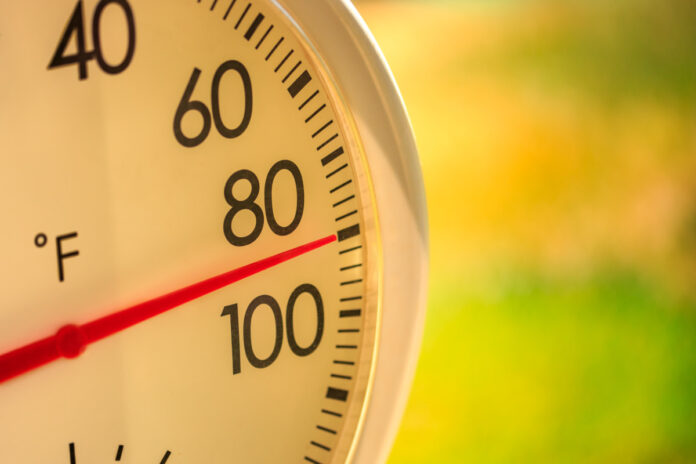HANCOCK COUNTY — August is typically known for its dog days. This week, there will be no doubt, with temperatures topping 90 degrees the rest of the week as the area sweats through the longest stint of hot weather of the summer.
Complicating the conditions is high humidity. The feels-like temperature neared 105 degrees on Tuesday, Aug. 24, as the National Weather Service issued a heat advisory for most of the state. People were urged to limit outdoor activity.
The average high temperature for this time of year is 84 degrees. By the time the heat finally breaks early next week, the county could crack 90 degrees for as many as nine straight days, with continued heat indexes in the triple digits, according to the weather service.
The conditions make it dangerous to those who work outside or who are exposed to the heat for too long, particularly if they don’t hydrate properly. The warning includes animals, which should be taken inside if possible. People with pets who stay outside need to remember to make sure their animals have a shaded area and plenty of fresh water.
Heat illness can overtake a person very quickly. Knowing the signs of heat exhaustion and heatstroke before it’s too late is key, said Sugar Creek Township Fire Department chief Brandon Kleine. By the time a person feels thirsty or fatigued from the heat, that’s usually too late.
“Hydration is very important,” Kleine said.
Signs of heat exhaustion include heavy sweating; cold, pale and clammy skin; fast, weak pulse; nausea or vomiting; muscle cramps; tiredness or weakness; dizziness and headache, according to the Centers for Disease Control and Prevention. Heatstroke, which is a critical medical condition that requires immediate attention, can follow heat exhaustion. Symptoms include a core body temperature of 104 degrees and above, alterations in perspiration, mental confusion, nausea/vomiting and headache.
Those suffering from exhaustion need to get out of the heat, hydrate, place a cool cloth on skin and remove hot clothes. Those suffering from heatstroke should be moved to a cool place; have their hot clothes removed; and have ice placed under their arms while help is summoned.
The danger is acute for people who work or play sports outdoors.
Officials with Southern Hancock schools noted when the area had a couple of 90-degree days earlier this month, coaches had athletes working outside take off their heavy gear, hydrate on a regular basis and take plenty of breaks.
“Our athletic trainers stay on top of this and monitor the temperatures through a heat index chart, and when it reaches a certain level they react,” communications director Wes Anderson said.
The state requires all schools to have a heat modification policy and follow it for player safety.
Greg Duda, public information officer for Hancock County Emergency Management, said while they know of no official cooling centers in the county, residents who need somewhere to cool off can use public places like the Hancock County Library to escape the heat.
“We also recommend people stay weather-aware with free text alerts from Smart911,” Duda said in an email to the Daily Reporter. “Users can customize the alerts they receive; like Excessive Heat Warnings, Heat Advisories or severe weather.”
Duda also reminds residents to check on the elderly and any at-risk neighbors. Hancock County Emergency Management also is posting helpful information on its social media pages.
If the weather continues to stay hot and dry, officials might have to make decisions surrounding outdoor burning and possibly fire bans. After an unusually wet spring and early summer, only about a third of an inch of rain has fallen in August. It has rained on only five days so far this month, according to National Weather Service data.
“I am sure that as we get closer to harvest season with no rain we will need to review or address a burn policy or even a burn ban,” Kleine said. “To my knowledge that has not been put in place as of now.”
[sc:pullout-title pullout-title=”Signs of heat exhaustion, heatstroke” ][sc:pullout-text-begin]
Signs of heat exhaustion
Confusion
Dark-colored urine (a sign of dehydration)
Dizziness
Fainting
Fatigue
Headache
Muscle or abdominal cramps
Nausea, vomiting or diarrhea.
Signs of heat stroke
High body temperature. A core body temperature of 104 degrees or higher is the main sign of heatstroke.
Altered mental state or behavior. Confusion, agitation, slurred speech, irritability, delirium, seizures and coma can all result from heatstroke.
Alteration in sweating. In heatstroke brought on by hot weather, your skin will feel hot and dry to the touch. However, in heatstroke brought on by strenuous exercise, your skin may feel dry or slightly moist.
Nausea and vomiting. You may feel sick to your stomach or vomit.
Flushed skin. Your skin may turn red as your body temperature increases.
Rapid breathing. Your breathing may become rapid and shallow.
Racing heart rate. Your pulse may significantly increase because heat stress places a tremendous burden on your heart to help cool your body.
Headache. Your head may throb.
How to avoid trouble
Wear loose-fitting, lightweight clothing.
Protect against sunburn.
Drink plenty of fluids.
Take extra precautions with certain medications.
Never leave anyone or an animal in a parked car.
Take it easy during the hottest parts of the day.
Get acclimated to the heat.
Be cautious if you’re at increased risk.
Stay hydrated; it is key to maintaining a healthy body temperature, particularly during exercise.
Be extra careful if you’re sick.
Use the buddy system when going outside.
Mind the temperature and time when going outside.
Use your oven less to help reduce the temperature in your home.
If you’re outside, find shade.
When inside, pull the shades and curtains.
Sources: www.ready.gov; Centers for Disease Control and Prevention; the Mayo Clinic
[sc:pullout-text-end]





